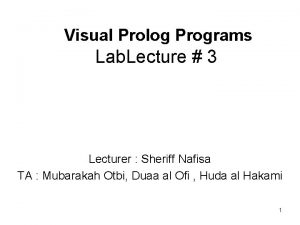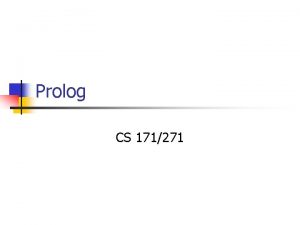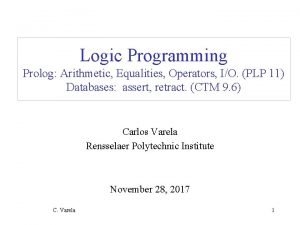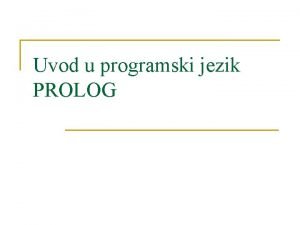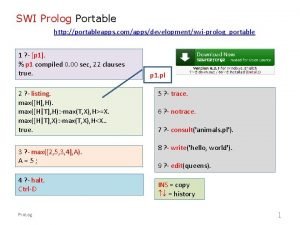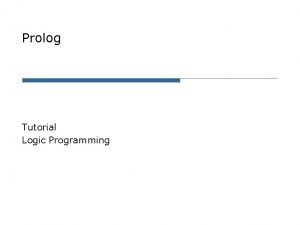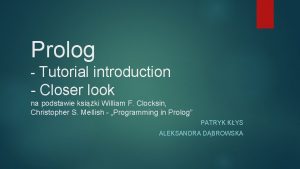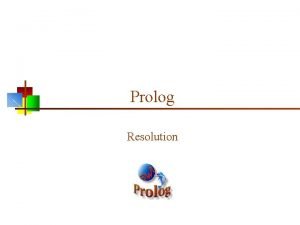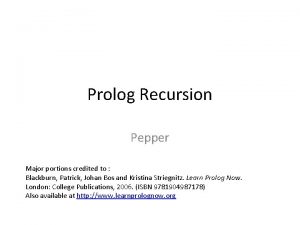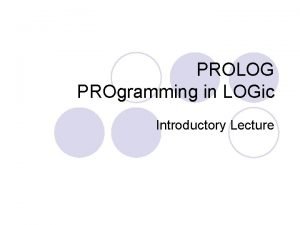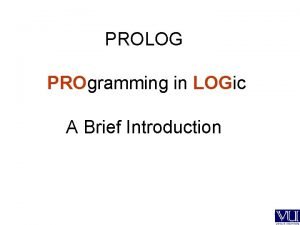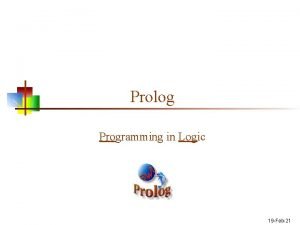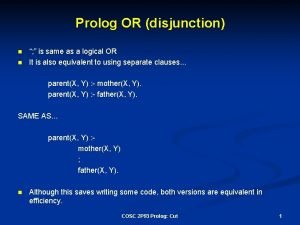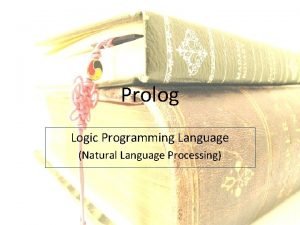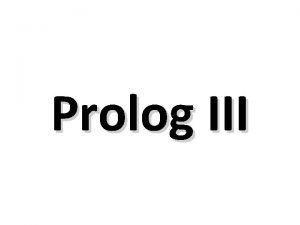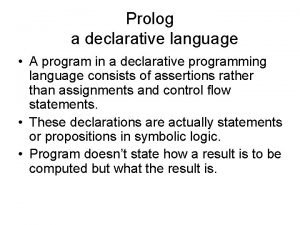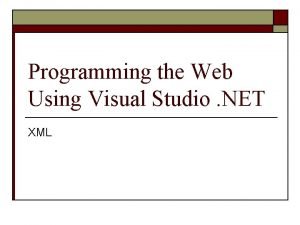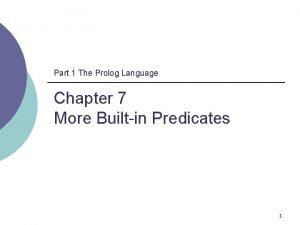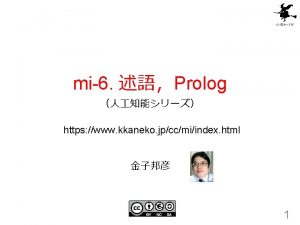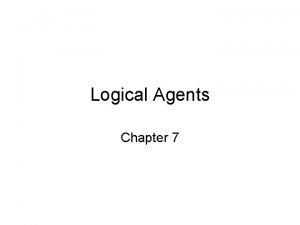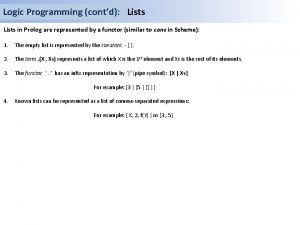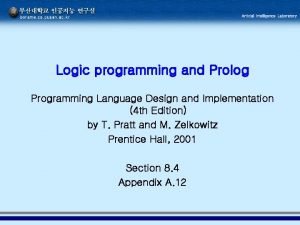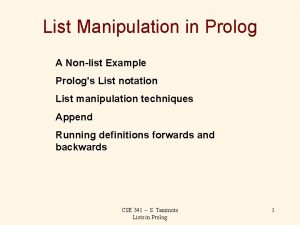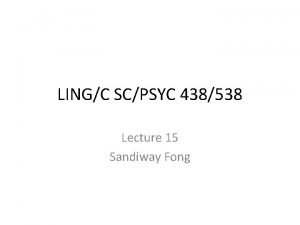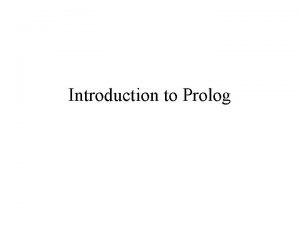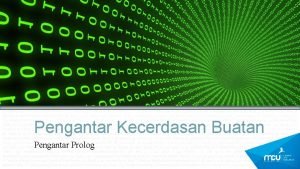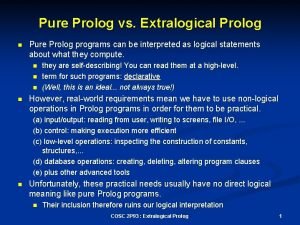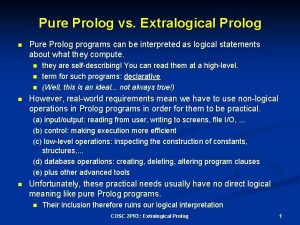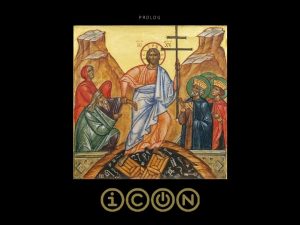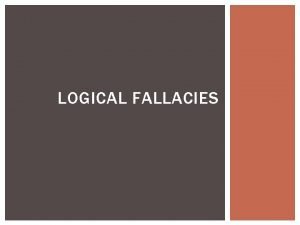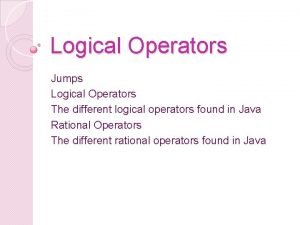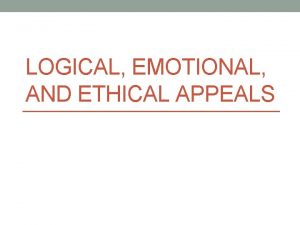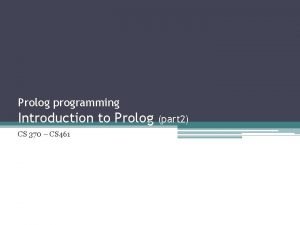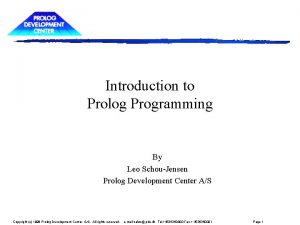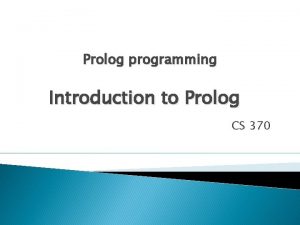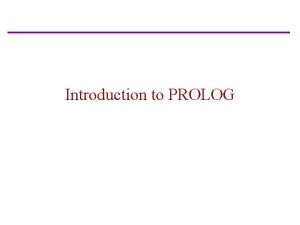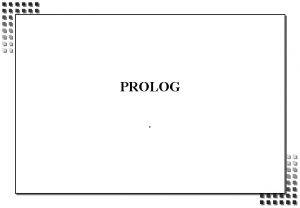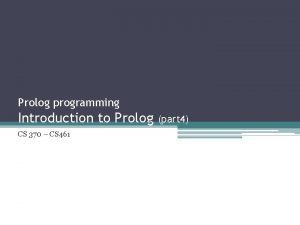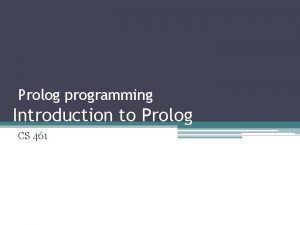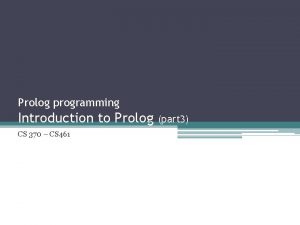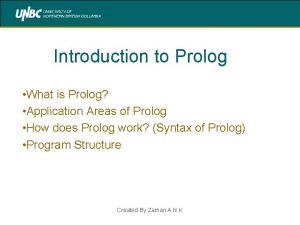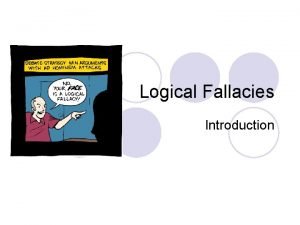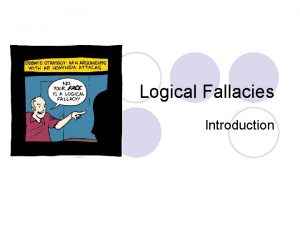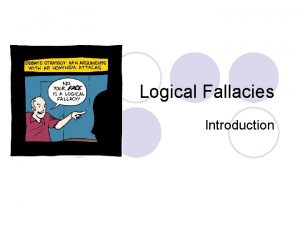Introduction to Prolog Introduction Prolog is a logical
































- Slides: 32

Introduction to Prolog

Introduction • Prolog is a logical programming language and stands for PROgramming in LOGic • Created around 1972 • Preferred for AI programming and mainly used in such areas as: § Theorem proving, expert systems, NLP, … • Logical programming mathematical logic programming. is the use of for computer 2

Introduction (Cont’d) • For symbolic, non-numeric computation • e. g. : parent (tom, bob). • Parent is a relation between its parameters: tom and bob • The whole thing is called a clause • Each clause declares one fact about a relation 3

How to Run • We will use SWI-Prolog, one of the many implementation used currently. • Developed at “Swedish Institute of Computer Science” • Start using SWI Prolog and you will get the Prolog prompt 4

How to Run (Cont’d) 5

Prolog • Prolog has an interactive interpreter • After starting SWI-Prolog, the interpreter can start reading your Prolog files and accept your queries. • To exit Prolog simply type the command ‘halt. ’ (Notice the full-stop) • Prolog program files usually have the extension. pl or. pro 6

Statements • There are three categories of statements in Prolog: § Facts: Those are true statements that form the basis for the knowledge base. § Rules: Similar to functions in procedural programming (C++, Java…) and has the form of if/then. § Queries: Questions that are passed to the interpreter to access the knowledge base and start the program. 7

Facts • A fact is a one-line statement that ends with a full-stop. § § § § parent (pam, bob). parent (tom, liz). male (bob). male (tom). female (pam). female (liz). 8

Rules • A Rule consists of § a condition part (right-hand side) body of clause § a conclusion part (left-hand side) head of clause § They are separated by ‘: -’ which means ‘if’ • offspring relation § offspring (X, Y) : X is an offspring of Y § X, Y (offspring (X, Y) parent (Y, X)) § offspring (X, Y) : - parent (Y, X). head body 9

Rules (Cont’d) • Variables in head of rules are universally quantified • Variables appearing only in the body are existentially quantified • Rules vs. Facts § A Fact is something unconditionally true § Rules specify things that are true if some condition is satisfied 10

Queries • Queries are questions • The engine tries to entail the query (goal) using the Facts and Rules in KB • There are two kinds of answer § Yes/No: parent (tom, bob). § Unified Answer/No: parent (X, bob). • Other possible answer(s) can be found using semicolon (return for stopping) • For example : parent (X, Y). X=pam Y=bob; X=tom Y=liz; no 11

Queries (Cont’d) • Q: Who is a grandparent of Jim? (using parent relationship) § § Who is a parent of Jim? Assuming “Y” Who is a parent of “Y”? Assuming “X” ? - parent (Y, jim) , parent (X, Y). If we change the order of them the logical meaning remains the same • Q: Who are Tom’s grandchildren? • Q: Are Ann and Pat siblings? 12

Where the program is written? • Facts and Rules are stored in one or more files forming our Knowledge Base • Files containing KB are loaded into the interpreter • After changing these files, the files should be loaded again to be effective • Queries are asked in the interactive mode in front of the question prompt: ? 13

Reading Files • consult (filename). § Reads and compiles a Prolog source file § consult ('/home/user/prolog/sample. pl'). • reconsult (filename). § Reconsult a changed source files. § reconsult('/home/user/prolog/sample. pl'). • [‘filename’]. § ['/home/user/prolog/sample. pl']. • make. § Reconsult all changed source files. 14

Examples • mother (X, Y) : - parent (X, Y) , female (X). • sister (X, Y) : parent (Z, X) , parent (Z, Y) , female (X). • What is wrong with this rule? • Any female is her own sister • Solution? 15

Comments • Multi-line : /* This is a comment This is another comment */ • Short : % This is also a comment 16

Prolog Syntax • Terms in Prolog: § Simple § Constants: § Atoms § Numbers § Integer § Real § Variables § Complex Structures 17

Atoms • They should consist of the following set of characters: § The upper-case letters § The lower-case letters § The digits § The special characters: +, -, *, /, <, >, =, : , . , &, ~, _ • Atoms should not start with upper-case letters or underscore and can be followed by any set of characters. • The scope of an atom is the whole program 18

Examples of Atoms • anna, x 30, x___y, miss_Jones • <---> , ==>, … , . : . , : : = (except reserved ones like : - ) • ‘Tom’ , ‘Sarah Jones’ (Useful for having an atom starting with a capital letter) 19

Numbers • Integer § limited to an interval between some smallest and some largest number permitted by a particular Prolog implementation § e. g. : 1, 1001 , 0 , -98 • Real § Not frequently used § e. g. : 3. 14 , -0. 0035 , 100. 2 20

Variables • Consists of letters, digits and ‘_’ • Starting with an upper-case or an ‘_’ • The variable ‘_’ (a single underscore character) is a special one. It's called the anonymous variable. • The scope of a variable is its clause § If the name X 15 occurs in two clauses, it represents two different variables. § Each occurrence of X 15 within the same clause means the same variable 21

Structures • Compound Objects • Each constituent is a simple object or structure. • e. g. : date (1, jan, 2007) • Components can be variables. • Any day in Jan 2007 date (Day, jan, 2007) 22

Conjunction and Disjunction • Conjunction , • Disjunction ; § P : - Q ; R. § P : - Q § P : - R • ‘, ’ has more priority § P : - Q , R ; S , T , U. § P : - (Q , R) ; (S , T , U). 23

Recursion • Define ancestor relation based on parent relation. • ancestor (X, Z) : parent (X, Z). • ancestor (X, Z) : parent (X, Y) , parent (Y, Z). • ancestor (X, Z) : parent (X, I) , parent (I, Y) , parent (Y, Z). • Solution is Recursion 24

Recursion • Remember from functional programming languages void func (int a , int b) { //base case if (condition) return; … // recursion func (x, y); … } 25

Recursion • Rules in Prolog are like functions in procedural programming languages • For recursion we should define the ancestor relation in terms of itself • Base Case : § ancestor(X, Z) : - parent (X, Z). • Recursion Step : § ancestor (X, Z) : - parent (X, Y) , ancestor (Y, Z). 26

How Prolog Answers Questions • Instead of starting with simple facts given in the program, prolog starts with the goals. In fact, Prolog does goal driven search. • Using rules, Prolog substitutes the current goals (which matches a rule head) with new sub-goals (the rule body), until the new sub-goals happen to be simple facts. • Prolog returns the first answer matching the query. When prolog discovers that a branch fails or if you type ‘; ’ to get other answers, it backtracks to the previous node and tries to apply an alternative rule at that node. 27

Example • Facts: § § parent (pam, bob). parent (tom, liz). parent (bob, ann). parent (bob, pat). parent (pat, jim). • Rules: 1. ancestor (X, Z) : - parent (X, Z). 2. ancestor (X, Z) : - parent (X, Y) , ancestor (Y, Z) • ? - ancestor (tom, pat). (goal) • The rule that appears first, is applied first • Unifying: {tom/X} , {pat/Z} § The goal is replaced by : parent (tom, pat). (sub-goal) • Fails backtracking 28

Example (Cont’d) • Applying the next rule 2. ancestor (X, Z) : - parent (X, Y) , ancestor (Y, Z) • Unifying: {tom/X} , {pat/Z} § § § New Goal: parent (tom, Y) , ancestor (Y, pat) Prolog tries to satisfy them in order in which they are written The first one matches one of the facts {bob/Y} Second sub-goal: ancestor (bob, pat) The same steps should be done for this sub-goal 29

Orders of Clauses and Goals 1. ancestor (X, Z) : - parent (X, Z). ancestor (X, Z) : - parent (X, Y) , ancestor (Y, Z). 2. ancestor (X, Z) : - parent (X, Y) , ancestor (Y, Z). ancestor (X, Z) : - parent (X, Z). 3. ancestor (X, Z) : - parent (X, Z). ancestor (X, Z) : - ancestor (Y, Z) , parent (X, Y). 4. ancestor (X, Z) : - ancestor (Y, Z) , parent (X, Y). ancestor (X, Z) : - parent (X, Z). 30

Orders of Clauses and Goals • It turns out that : § The first and second variations are able to reach and answer for ancestor. § The third sometimes can and sometimes can’t § And the forth can never reach and answer (infinite recursion) • “Try simple things first”. 31

More about Prolog • A collection of facts and rules is called a knowledge base (KB). • Prolog works based on “first-order predicate logic” • Matching corresponds to what is called “Unification”. • Prolog has no data types 32
 Visual prolog examples
Visual prolog examples Download prolog
Download prolog Prolog arithmetic
Prolog arithmetic Logical form and logical equivalence
Logical form and logical equivalence Kesetaraan logis adalah
Kesetaraan logis adalah Introduction to prolog
Introduction to prolog Fail rp primjeri
Fail rp primjeri Prolog portable
Prolog portable State space search ai
State space search ai Two houses both alike in dignity
Two houses both alike in dignity Prolog tutorial
Prolog tutorial Prolog tutorial
Prolog tutorial Proposition examples sentences
Proposition examples sentences Prolog recursion
Prolog recursion Features of prolog
Features of prolog Variables in prolog
Variables in prolog Lisp and prolog
Lisp and prolog Disjunction in prolog
Disjunction in prolog Prolog natural language processing
Prolog natural language processing Prolog head tail
Prolog head tail Blocks world problem in ai
Blocks world problem in ai Is prolog declarative language
Is prolog declarative language Prolog in xml
Prolog in xml Prolog mobile
Prolog mobile Findall prolog
Findall prolog Concat prolog
Concat prolog Prolog criado por
Prolog criado por Prolog
Prolog Wumpus world peas description
Wumpus world peas description Prolog programming
Prolog programming Logic programming language
Logic programming language List manipulation in prolog
List manipulation in prolog Prolog cheatsheet
Prolog cheatsheet
